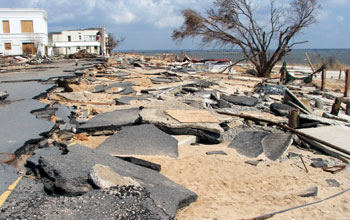Multimedia Gallery
Georgia Tech Experts Respond to Katrina (Image 2)
At Bay St. Louis, Miss., undergraduate student Justin Singleton surveys the storm surge height from Hurricanes Katrina and Rita based on the bark stripped off a tree. The rod he is holding measures 7.7 meters long.
With support from a National Science Foundation (NSF) grant (05-53144), David Frost--professor of civil and environmental engineering at Georgia Institute of Technology, Savannah--organized three teams of researchers and graduate students to conduct week-long field studies to assess infrastructure damage in the Gulf Coast region in September and October 2005.
Frost's team also analyzed wind and storm surge damage data they collected from across the Gulf Coast region, which they hope may be used to help define a zone that is potentially subject to certain types of damage. Then according to Frost, engineers could design structures within a certain distance of the shore to a higher standard than those farther inland. For example, in Savannah, one set of building codes applies to structures on the east side of Interstate 95 and another set applies to buildings on the west side of the highway.
Frost and his colleagues have conducted numerous post-disaster reconnaissance studies following major natural and human-induced events, including earthquakes in Asia and California, the Indian Ocean tsunami and the 9/11 terrorist attacks in New York City. To learn more about their research visits, see Georgia Tech news release In the Hurricanes Wake: Georgia Tech Experts Respond to Katrina and Rita with Research, Training and Service Projects.
(Date of Image: September or October 2006) [One of 4 related images. See Next Image.]
Credit: Image courtesy H. Fritz, Georgia Tech Savannah
Images and other media in the National Science Foundation Multimedia Gallery are available for use in print and electronic material by NSF employees, members of the media, university staff, teachers and the general public. All media in the gallery are intended for personal, educational and nonprofit/non-commercial use only.
Images credited to the National Science Foundation, a federal agency, are in the public domain. The images were created by employees of the United States Government as part of their official duties or prepared by contractors as "works for hire" for NSF. You may freely use NSF-credited images and, at your discretion, credit NSF with a "Courtesy: National Science Foundation" notation.
Additional information about general usage can be found in Conditions.
Also Available:
Download the high-resolution JPG version of the image. (2.3 MB)
Use your mouse to right-click (Mac users may need to Ctrl-click) the link above and choose the option that will save the file or target to your computer.

